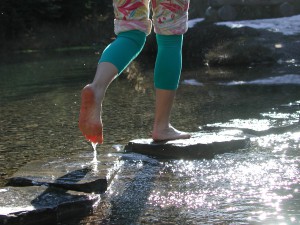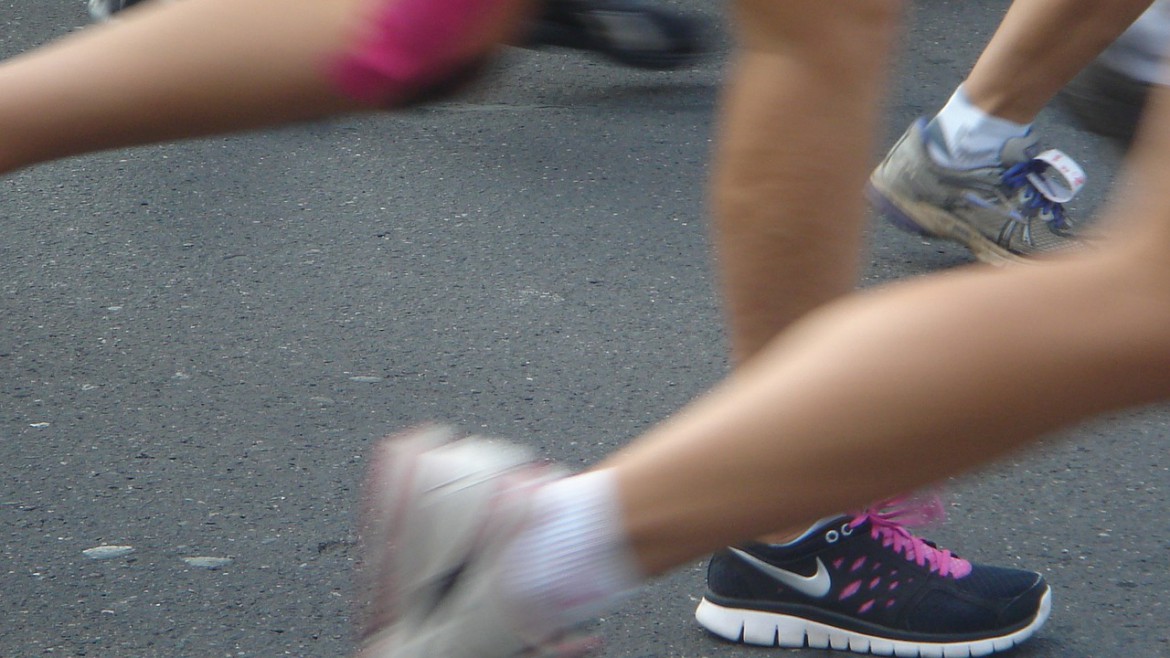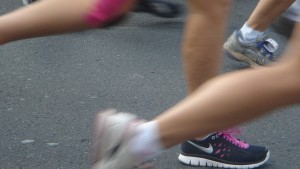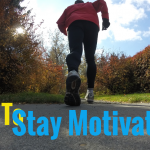Your Natural Groove
There is a running cadence, a number of strides per minute, that feels right for you – the groove you naturally land in when you lace up the shoes and head out. For most of us, on a typical medium intensity run, that natural groove will fall somewhere between 82 and 90 strides per minute.
It feels good. It feels natural. It feels normal.
But how “natural” is it? And is it helping you?
Never thought about it?
Consider this.
How Healthy are We?
Every year 56% of runners suffer a running-related injury. 90% of runners training for a marathon will get sidelined at some point during training because of injury. We’re much of the time in the perverse situation of the thing that makes us healthy being the thing that stops us from continuing to be healthy.
Cadence, surprisingly, might be one simple thing that can help us hang in there.
Test Out True Natural
The majority of us wear running shoes (although I’ve seen army boots and flip flops.)
For good reason. Pavement. Stones. Snow. Mud. Broken glass.
But when you think about a natural cadence, take your shoes off and see what happens. You find out pretty quickly you can’t run at the same cadence you used to. Your feet become very unhappy. Very quickly.
Until you start landing much more softly and evenly. And to do that, you speed things up and shorten your stride.
90 strides per minute turns out to be a very happy place when your shoes are way back there.

Unfiltered by the padding of running shoes, your body knows what it needs. It wants your feet landing flatter to even out the contact. It wants your stride shorter to minimize heel strike and cushion the landing impact
Without shoes, your body forces you to do what’s good for it.
Quicken Your Cadence a Little and Prevent Injury A lot
Now, go ahead and put your shoes back on if that’s your thing. If not, that’s cool too.
It turns out that if you can increase your cadence by not a lot (5 to10%) from your preferred cadence – the one you normally would use, fully shod – you can really decrease the load on your knees, ankles and hips, and, by extension your risk of injury.
A study at the University of Wisconsin concluded that as little as a 5% increase from your preferred cadence will reduce energy absorption at the knee joints by 20%. If you can increase your cadence by 10% you’re going to get 34% less energy absorption in your knee.
Thirty four percent less energy absorption in your knee. That means your knee needs to do 34% less work than it would otherwise. It means 34% less wear and tear. It means your knees can take the rest of the year off starting August 30.
Establishing Your New Comfort Zone

A 5% increase in cadence isn’t much. It’s do-able in a couple of weeks. 10% is also do-able – 5% at a time. The study found that above 10%, runners weren’t actually working any harder – their hearts and lungs showed no greater stress – but the runners themselves thought they were.
So increasing your cadence 5% to 10% (not increasing your speed remember, just cadence) might not be as much a stretch as you think.
 And there are tools to help. I have a free app on my Android called Runzi which has pretty much everything you need to track your cadence including a metronome to keep you on pace. If music’s what keeps you going, plug in “Rock and Roll“, “Madness” or “Tears over Beers” to help you out (all at that 90 beat-per-minute pace).
And there are tools to help. I have a free app on my Android called Runzi which has pretty much everything you need to track your cadence including a metronome to keep you on pace. If music’s what keeps you going, plug in “Rock and Roll“, “Madness” or “Tears over Beers” to help you out (all at that 90 beat-per-minute pace).
All of this means getting out of your comfort zone for a while. And establishing a new one.
The best “natural” cadence is the one that keeps you running healthy.
And it’s probably a little quicker than the groove you’re in now.








I remember when I first started running and how I never paid much attention to cadence and its importance. I then got into trail running and realized through experience just how big of an impact cadence has! Just like a mountain bike switching gears, following the same pattern of quicker cadence up hill and longer strides down hill has helped me tons!
Thanks for the informative article as it enforces the importance of cadence and running mechanics.
Thanks for the comment Wing. It’s sometimes not as easy in trail running to keep track – you’re busy a lot of the time – but you’re definitely switching gears a lot, as you say, and it’s a lot more fun. Right? All the best. See you out there.
I used to run cross country when I was younger. Haha my cadence was really low as I was out of shape haha. Now I usually run about a mile on the treadmill. I haven’t tested or measured my cadence in a while, though I do have sort of an interval threshold I like to work. I go hard one minute running and then back to a walk and alternate. Within that hard minute I’d say my cadence is fairly high.
Will, I think you’re wise to run and then walk. Certainly Jeff Galloway would agree.
It’s a good way to keep running and stay injury free.
Keep on keeping on!
I use an app too with a metronome when I’m running too. And have a playlist with music to keep the pace up. I am dependent on those things.
You have written a very informative piece on running cadence here, Larry. It’s bad that running leads to injuries.
Love your site.
Andreas
It’s terrific that you run with a metronome or music playing Andrea. It takes away a lot of the guesswork.
And, yes, it’s too bad that runners tend to be beating back injury all the time – the statistics aren’t great – but there is help. I wrote in another post (Beginning Running Over 50 – Can You Do It?) about Jeff Galloway’s run-walk-run programs. I’m just recovering from an injury right now and it’s been a terrific way to get back in shape.
If you do get injured, heaven forbid, he’s a great resource.
All the best.
See you out there.
I can’t say I enjoy running, but this is very interesting. It is so easy to get hurt. I never thought our shoes could be keeping us from listening to our bodies. I know I’ve heard of some people running without shoes, but I’ve also heard that it can hurt your feet without support for your arches. Is there any truth to that?
Good question Shannon. Yes, you definitely can be hurt by stepping barefoot on something sharp or hidden. No two ways about it. I’ve run barefoot at times and I’ve had the occasional scrape. But there are some significant benefits too, other than improving your cadence and decreasing injury.
A study at the University of Cincinnati (http://www.sciencedirect.com/science/article/pii/S…), has shown that running over time in minimalist shoes will actually strengthen your feet – versus running in traditional “full support” shoes. It can definitely help your arches – if your switch to minimal is started slowly and you increase your minimalist mileage gradually.
That’s the science.
But then there’s that huge amount of just plain joy (right?) when you kick off your shoes and walk around on some grass. Your body just knows what it likes. And it’s happy hopping around unshod. Yes, keep an eye on where you’re stepping, but by all means enjoy. You’re doing your body, and your feet, good!
Great post, I was talking with a PT co-worker of mine about this a while back.
But this post seemed to make it easier to understand the concept of finding your natural cadence.
This just makes so much more sense that if you cadence is smooth and symmetrical that you’re going to have less wear and tear on your body.
Running’s a great way to keep in shape, thanks for the awesome post.
Todd
Glad it helps Todd.
Larry
Love this – very factual and spread nicely and evenly. Is there anything specific I should be eating (slow release carbs, etc) that will help me run. I took up running recently and really want to improve my cadance quite dramatically. I’m not one to hold back and patience definitely isn’t a virtue for me. Any shortcuts i can use to improve quite fast?
Good questions Daniel. It all depends on what you want to do, and on what you want to improve. Quickening your cadence as little as 5% will help prevent injury, because what you’re doing is shortening your stride length and reducing the loading on your joints. You should be going the same speed as you were before, just with a quicker cadence.
In any athletic endeavour the paradox is if speed is what you want to improve, do it slowly. There are a lot of great running programs available. My favourites are by Jeff Galloway. He has them for every level of runner and speed target. Set a target time, figure out where you are on his programs, and go from there. (I’m assuming your doctor is fine with you going ahead and running.)
If distance is what you want to improve, the same applies. Increase a little at a time. The general rule is no more than a 5% increase in total distance per week. So if you’re running 3 miles a week now, next week increase your distance by about 260 yards – total. Which is an increase of about 3 city blocks for the whole week. Not much right? But in 50 weeks at that rate of increase you’re up to about 35 miles a week, which is marathon-training distance for some.
All depends on what you want to do.
As for food, other than sticking to the outside aisles of the supermarket as much as possible and avoiding junk food, I don’t know of any specific foods that will help you run. If anything, runners are notorious (and I’m no saint) for eating healthy in the main but for indulging in periodic food lapses. Your body is going to start telling you what fuel it needs. Just gotta listen to it.
See you out there!